Fundy Issues #22
AUTUMN 2002
TAKING FUNDY'S PULSE
Monitoring the Health of the Bay of Fundy
— healthy human communities can only flourish within healthy ecosystems." Sea Sick!
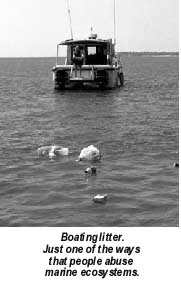
Humans have long exploited and abused the world's oceans and their natural resources. Toxic chemicals, plastic debris and other wastes are strewn from the tropics to the poles and from coastal lagoons to the open ocean far from land. Overfishing has devastated populations and communities of marine animals and plants. Species have been decimated (e.g. cod, salmon) or pushed to extinction (e.g. Great Auk). Once productive marine habitats have been battered by destructive fishing practices, fouled by unfettered pollution, scarred by unregulated coastal development and devastated by many other human activities. Much of the degradation of coastal seas is a result of human activities on the land, often far removed from the coast. Conditions in general are getting worse, not better!
The Bay of Fundy is no exception to this trend of deteriorating coastal ecosystems. Ecologists and environmentalists have warned for decades that its ecosystems are stressed by human activities and that worrisome changes are taking place. Some of the more pressing problems have been considered recently at the Bay of Fundy Science Workshops, initiated by the Bay of Fundy Ecosystem Partnership (B0FEP), and also described in earlier Fundy Issues. Fortunately, the population size and industrial development around the Bay are much less than along many other coastlines. Consequently, habitat loss and chemical contamination are not yet as severe or obvious as in more developed areas. However, we shouldn’t assume that, since the Bay is still "fairly healthy", we can continue our harmful activities. We need to monitor those environmental changes that we know, or suspect, are taking place to determine whether conditions are still deteriorating. We need "early warning’ systems that enable us to detect emerging problems quickly and avert further reduction of species, other crises and the ecological degradation that afflicts many other coastal areas.
Sea Services
There are many reasons why we should be interested in having healthy and productive terrestrial and aquatic ecosystems in the Fundy region. At the very least, we ought to be concerned about the implications for our own health. The water we drink, the air we breathe, and the food we eat link us intimately to our environment. Man-made industrial and agricultural chemicals, spreading insidiously and invisibly through the air, water and soil, can slowly poison us. Toxic compounds are also produced naturally by some marine phytoplankton. For much of the year, these noxious algae are generally not very abundant in coastal waters, but when conditions are right, they multiply rapidly and form dense "blooms" such as the infamous "red tide". However, if too much fertilizing nutrient is flushed into coastal waters from sewage plants, farm fields or golf courses, many types of algae, including the very toxic ones, "bloom" even more frequently. These poisons may accumulate in shellfish and other organisms, and if we consume them may sicken or kill us. Abused and fouled ecosystems are also more likely to harbour populations of dangerous bacteria, viruses or other disease-causing microorganisms. Human health and ecosystem health are clearly two sides of the same coin - healthy human communities can only flourish within healthy ecosystems.
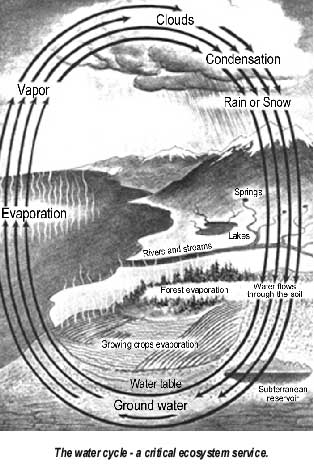
The natural environment also provides many valuable services at little if any cost or effort on our part. One such example is the great water cycle that endlessly moves the Earth’s seemingly limitless supply of water through oceans, lakes, rivers, underground aquifers and atmosphere, constantly cleaning and purifying it as it circulates. However, in many places people have fouled the water far beyond nature’s large, but limited, capacity to purify it. As a result, cities and towns build costly water treatment plants simply to have the clean, safe drinking water that nature once provided freely. The traditional fisheries yield other instances of valuable ecosystem services that have been diminished or destroyed, at great cost to coastal communities. For example, tens of thousands of Atlantic salmon once teemed in Fundy rivers, sustaining livelihoods and supplying abundant food. These vast stocks fed, reproduced and maintained themselves at no cost or effort to those who eagerly harvested the bounty. For aeons, nature "managed" these seemingly inexhaustible stocks sustainably and well. In recent centuries, resource managers have not been as effective at managing the activities that deplete salmon stocks and degrade their habitats. Today, there are pitifully few wild salmon remaining, despite decades of operating costly fish hatcheries to try to compensate for the decline in natural spawning runs. The salmon bounty of Fundy is now mostly produced in floating cages, fed processed food and treated with an array of expensive medicines to keep them healthy.
The list of such important "ecosystem services", taken for free and for granted, is almost endless. However, it is only when we heedlessly cripple them and then pay dearly to restore them that we realize their important role and economic value. Unfortunately, our economic accounting consistently fails to recognize the true value of these natural services when it tallies up the costs and benefits of human activities that affect the environment - it is simply assumed that they are free. We aren’t properly balancing the books, but are instead cheating both nature and ourselves. Because ecosystem services do not appear as valuable assets on our economic ledgers, we inevitably take them for granted and eventually abuse and degrade them. The monetary value of all the ecosystem services that nature provides is difficult to calculate because we don't always understand the full benefits of most natural processes. Nevertheless, Dr. R. Costanza and colleagues at the Institute for Ecological Economics at the University of Maryland have made a rough estimate. In an article published in the journal Nature in 1997 (see Further Information), they calculated that just the marine part of the global ecosystem provides goods and services worth at least US$33 trillion per year. This is more than 60 times the value of the annual production of the Canadian economy during the 1990's. The bulk of this "ecological value" tabulated by Costanza included resources and services above and beyond the obvious market value of the traditional commercial fisheries. We need to include the value of these seemingly "free" natural goods and services in our economic accounting in order to further emphasize the importance of conserving healthy ecosystems.
Planet as Patient
In recent decades, some scientists have suggested that we should be thinking about the health of our ecosystems in much the same way that we think about our own health. David Rapport, a professor in Faculty of Environmental Sciences at the University of Guelph in Ontario, has been at the forefront in promoting such an "ecosystem medicine" approach to dealing with environmental degradation. Considering the planet, or significant parts of it, as a "patient" may be the next logical step in a progression that is already taking place. Concern about the health of individual humans has already expanded to encompass the concept of the "community health" of groups of people. We also talk about "environmental health" in human medicine, usually in terms of the effect of particular chemicals or environmental conditions on people. Farmers and wildlife managers also tend to think in terms of "population health" in regard to livestock herds or wildlife stocks. The next step might be to consider the whole ecosystem as a "patient", whose overall well-being can be monitored and assessed. The "patient’ in this case would consist of all the species in a particular region, their complex biological processes, and the interactions among them and with their environment.
This "medical" analogy may be most useful as an educational tool in the context of the health of ecosystems. People are already well acquainted with many of the concepts and terms used in traditional medicine. Physicians are on the alert for "symptoms" of declining patient health. Similarly, ecologists are often aware of worrisome changes (symptoms) happening in ecosystems. These include such events as reduced catches in commercial fisheries, changes in the nature of intertidal sediments in estuaries or a sudden die-off of particular animals or plants. Once alerted to a problem, the doctor usually checks the patient’s "vital signs" such as pulse, temperature, and respiration rate to get a general overview of his condition. Similarly, an ecologist might check his aquatic "patient" by measuring the rate of primary production, the biodiversity (number of different species and their relative abundance) or the quality of the water and sediments. On the basis of these initial tests, both the doctor and ecologist then make a provisional "diagnosis" or statement about the underlying problem. The doctor might suggest that a bacterial infection is causing the fever, while the ecologist might conclude that pollution in the estuary is responsible for the poor fish catches. A good doctor and a good ecologist would both carry out further tests on their patients to confirm the initial diagnosis. Having all the needed information to hand, both practitioners would make a "prognosis’ or assessment of the prospect of recovery and then prescribe a "treatment" or "remedy" for the problem. The doctor might prescribe a course of antibiotics, a surgical procedure or simply two aspirins and a good night’s sleep. The ecologist might suggest that the fisheries problem would be alleviated if the sewage were properly treated before release into the estuary, if dumping of toxic effluent from an industrial plant were halted, or if a dam were removed from the river. Obviously, these are simplistic examples, and typically both doctors and ecologists are faced with much more complex problems that tax their knowledge and skills. However, considering the ecosystem as a "patient" may often be helpful in thinking about environmental problems and possible solutions.
Using terms and ideas derived from human medicine to discuss the health of whole ecosystems also forces us to recognize an important difference: when it comes to environmental degradation, human beings are usually both the cause and the cure, or the disease and the doctor. Our activities are responsible for the illness, and our ingenuity must diagnose and cure it. This creates a potential for conflict of interest, since many activities, such as damming rivers for generating electricity or clearing forests for agricultural production, are considered beneficial to us. However, the ecological consequences may be detrimental to us in the long run. At least when dealing with a disease or a parasite, a physician's goal is straightforward: identify and eradicate the problem. But "ecological doctors" usually can't prescribe the complete cessation of ecologically damaging activities such as clear cut forestry or bottom trawling. Instead, they have to find ways of changing the manner in which the activity is carried out, so that environmental impacts are eliminated or reduced. It’s a delicate balancing act, comparable to a physician having to promote the interests of both disease and patient without killing either.
Assessing the health of ecosystems can also be more difficult than monitoring an individual's health in other respects. The abundance of different species and many of the physical and chemical characteristics of the environment fluctuate naturally, sometimes in regular cycles, but more often unpredictably. Such features can vary considerably, without necessarily making the ecosystem "unhealthy". When an animal population increases or decreases suddenly, or some other characteristic of the ecosystem shifts dramatically, the ecologist immediately has to determine if the change is just another natural fluctuation or an indication of something more worrisome. Nowadays, no ecosystem is truly "natural" and free of the effects of human activities. Often, there isn't a "normal baseline" against which change can be measured. A doctor knows that if his patient's body temperature is even a degree or two above or below 37°C, there may be a serious problem. However, there are few such constant, critical measurements to warn ecologists that the health of an entire ecosystem is failing.
Indispensable Indicators
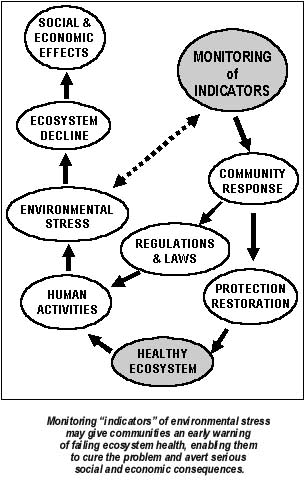
We are all familiar with the concept of a "medical checkup", whereby a doctor periodically measures a patient's "vital signs" to make sure that bodily processes are functioning normally. This is particularly important for those who are considered "at risk" for specific ailments. Shouldn’t we be just as concerned about the well-being of our terrestrial and aquatic surroundings, particularly the more vulnerable parts? At present, we usually don’t recognize degradation of our environment until conditions become too troublesome or costly to ignore. By then the economic cost, in terms of loss of ecosystem services and repair of the environmental damage, can be very high. The recent collapse of the Northwest Atlantic cod fishery is a particularly dramatic example of a failure to recognize the mounting signs of an impending ecological crisis. Proponents of "ecosystem medicine" argue that the environment should also have regular health "check ups" using selected "ecological indicators". Ecologists would thereby have an early warning of problems developing in the ecosystem. They could then look more closely, identify the cause of the "environmental sickness" and recommend a cure. This would permit timely and far less costly action to avoid further ecological, economic and social catastrophes.
One of the difficulties in carrying out regular check-ups on the health of people or ecosystems is knowing which of the myriad variables to measure. Over the centuries, physicians have discovered many useful "indicators" that give a quick overview of a patient’s health. During an annual check up, a doctor performs a number of general tests as well as specific tests suited to particular situations. Some of the general measurements, such as body temperature, reflex response, heart rate and blood pressure, are made on everyone. Other tests are tailored to men or women, the young or elderly, or existing health problems. The test results are compared with the average values for healthy people. If any measurement is significantly above or below average, the doctor is alerted to a possible problem that needs further examination.
In marked contrast, ecologists are still searching for the ideal set of reliable indicators of the health or sickness of ecosystems. Inevitably, given their complexity and diversity, there is much debate and little agreement. In the natural world there are simply too many different species involved, too many complex ecological processes taking place and a too little understanding of how the parts interact. We need to find and regularly monitor a few representative "indicators" that reflect the general health of the whole ecosystem and thus inform us if it is healthy or not. The current use of the common blue mussel as a "sentinel species" to monitor the concentrations of various chemical contaminants in coastal waters around the Gulf of Maine is described in Fundy Issues Number 12, Gulfwatch: Putting a little mussel into Gulf of Maine marine monitoring.
Unquestionably, we will have to use different "indicators" for different ecosystems. After all, doctors don’t usually test children for osteoporosis or give men a mammogram! Similarly, a good measure of the health of a salt marshes may not be applicable in the intertidal zone or boreal forests. The question is, which features do we measure to gauge the health of the different ecosystems of the Bay of Fundy? One possible approach is to use "indicator species". Such species may be sensitive and live only in clean, healthy ecosystems. As long as they are abundant, seemingly healthy and reproducing, it is likely that their habitat is also healthy. Lake trout, for example, are finicky about the quality of the water they live in. If it becomes too contaminated, too warm or too murky they leave or die. In contrast, other tough, opportunistic species such as polychaete worms can live contentedly in degraded habitats that would kill a trout. Some thrive in sewage-contaminated, oxygen poor bottom sediments and are thus considered good indicators of a degraded environment. If routine monitoring reveals that their numbers are rising, then there is likely a problem in the bottom habitat.
However, there are problems with using indicator species. Some forms of environmental degradation may not affect otherwise sensitive organisms. Lake trout, for example, while particular about water quality, may not be influenced by pollutants accumulating in the sediments, or by the declining health of marshes around the lake. In addition, populations of many species fluctuate greatly and unpredictably even under natural conditions, for reasons that we often don’t understand. If our blood pressure or body temperature varied in a similar fashion, then doctors would have to throw out their sphygmomanometers and rectal thermometers as diagnostic tools!
Many ecologists suggest that monitoring the presence or absence of indicator species is simply inadequate for assessing ecosystem health. Instead, we should monitor the rate at which important ecosystem processes occur and the general pattern of these processes. These are what ecologist T.P. Simon (see Further Information) calls the "biological response signatures" of communities of organisms. This is comparable to a doctor measuring a patient’s respiration rate, his brainwave activity or his heart rate, and considering all of them together, rather than simply noting whether he was alive or dead. Ecosystem processes might include the rate of photosynthetic primary production by all the plants in the ecosystem, the rate at which the major nutrients are recycled, or the ratio of the organic production to the respiration rate of the whole community. Other useful ecosystem health indicators could include the relative abundance of different species or "biodiversity", the prevalence of diseases or parasites, or various measures of water quality, especially oxygen levels.
Monitoring and Measuring
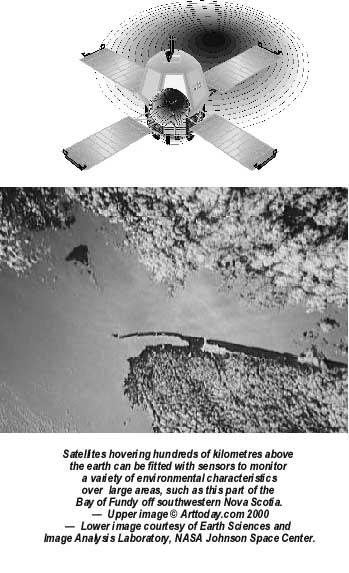
Discovering a meaningful set of environmental indicators is only the first step towards protecting the health of coastal ecosystems. More importantly, we need to determine how and when to use the indicators, how to collect the large amount of information required, and how best to analyze, synthesize and report the results. To monitor the health of our environment in a meaningful way, we need to measure many different characteristics, at widely scattered places, and at regular intervals. Optical measuring devices carried by aircraft or satellites enable us to measure some environmental variables over large areas in a very short time. For example, satellites can provide frequent "snapshots" of the water temperature or the amount of plant pigment near the surface over large expanses of ocean, such as the whole Bay of Fundy. Similarly, planes fitted with appropriate sensors can provide regular updates on the changing vegetation cover over entire watersheds. This is aptly called "remote sensing" because a large amount of useful information can be collected from a great distance away. Computers, running powerful programs called "Geographic Information Systems" (GIS), can quickly process huge amounts of remotely sensed data and present the information in many different ways. Relatively subtle changes occurring on the land’s or ocean’s surface can be observed and monitored in real time!. Although detecting such changes is steadily becoming easier, understanding their long-term ecological implications is still difficult.
Useful as remote sensing may be, many critical environmental changes still have to be studied closely and "hands on". Scientists can only measure the amount of heavy metals in intertidal sediment or the abundance of noxious bacteria in rivers by actually collecting samples of mud or water and taking them into the laboratory for analysis. While many laboratory tests are becoming more automated and rapid, collecting the samples in the field is still slow, costly and time consuming. There aren’t enough scientists and technicians to do all the sampling in all the places that need to be monitored to provide an early warning of environmental problems. In an era of tight budgets and diminishing staff, many scientists are looking towards community and environmental groups to collect samples, make observations and report data. Typically, the scientific partners assist in selecting appropriate sampling methods, ensuring the quality of the data, analyzing the results and then in interpreting and reporting the findings. Some volunteer groups across the Fundy region already routinely check water quality of rivers, lakes or estuaries, air quality and a variety of other ecological indicators of ecosystem health.
Naturalists in the Maritimes are also involved in tracking changes in the distribution and abundance of many groups of "indicator" organisms, such as herpetofauna (amphibians and reptiles), endangered plants, noxious weeds, lady beetles, loons and worms. Others participate in the annual Christmas Bird Count, the Feeder Watch or the Breeding Bird Survey, all of which provide detailed information about changes in the province’s bird populations over time. The "Thousand Eyes’ project, launched recently by the Nova Scotia Museum of Natural History, adds an interesting new twist to a century old effort at environmental monitoring. Between 1900 and 1923, A.H. MacKay, the Superintendent of schools in Nova Scotia, had students in 1,500 schools across the province observe and record the annual timing of 200 different natural events, such as the first blooming of common plants, the appearance of migratory birds as well as weather related phenomena such as the first snow, the freeze up of lakes or the last frost. Recently, students and naturalists have been recruited by the Museum to collect new information about the annual timing of many of the same natural phenomenon. A comparison of the old and new observations may provide clear evidence about the extent and ecological effects of climate change in the Atlantic region.
Reporting on Fundy’s Health
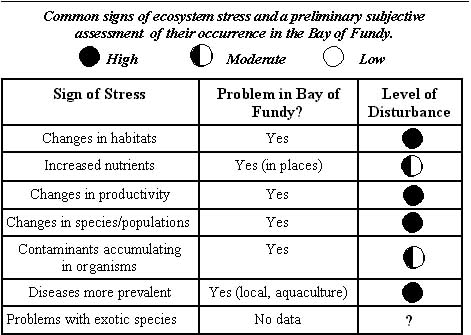
Long-term monitoring programs need to be carried out under the auspices of established, stable institutions that can provide continuity, funding and a secure archive for the expanding databases of environmental data and information. Thus, government agencies, universities and museums are vital lead partners in environmental monitoring programs. The findings of such monitoring programs need to be compiled periodically in a meaningful way and presented to the scientific community, environmental managers and the general public. This enables them to determine if environmental conditions are deteriorating, improving or unchanging and if environmental clean-ups, restorations or other conservation projects are needed or are effective. Perhaps the most credible and useful way to present the results is to prepare periodic "State of the Environment" (SOE) reports for regions of particular interest. These contain the results of all the monitoring programs, summarizing the trends shown by the different indicators and pinpointing any emerging environmental problems. The information collected can be presented in many different ways, depending on the audience. One method is to assign an index value to each of ten different ecological "indicators". The values might range from 1 for an uncontaminated or undisturbed state to 10 for a very contaminated or disturbed condition. The values for each of the selected "indicators" are then added to yield a composite index value that supposedly reflects the overall condition of the environment - the higher the index the greater the degree of disturbance. The index is recalculated at regular intervals to monitor improvement or deterioration in the health of the ecosystem. A table with small circles of different colours, representing the varying levels of disturbance for each of the indicators, is sometimes used to more visually summarize the results. Typically, green indicates a relatively undisturbed state, yellow or orange warns of possible problems and red signifies serious degradation. Most of the proposed reporting methods have flaws and may be subject to misinterpretation and thus have to be used with caution, but a periodic, readily understood "report card" of ecosystem health is essential (see table on page 7).
Progress is being made slowly in finding innovative and effective ways to monitor and evaluate the health of marine ecosystems such as those of Fundy. Much still remains to be done to make ecosystem health assessment as routine and reliable as that for human health. How we as a society respond to present and future warnings that key parts of Fundy’s ecosystems are in trouble because of our activities in coastal waters and watersheds is another question, involving a complex mix of social, political, economic and ecological considerations. But we are at least increasingly able to make more informed decisions, being better aware of the probable consequences of our actions or inaction. This is a decided advance over waiting in blissful ignorance for yet another environmental crisis to occur, or for the "Bay’s pulse" to falter or change in ways unseen!
Further Information
The Value of the World’s Ecosystem Services and Natural Capital. R. Costanza et al. Nature. Volume 387, pages 253 to 260. (1997). A Sea of Troubles. Joint Group of Experts on the Scientific Aspects of Marine Environmental Protection (GESAMP), Reports and Studies, Number 70. 35 pages. (2001). Indicators of Ocean Health and Human Health: Developing a Research and Monitoring Framework. A. Knap et al.Environmental Health Perspectives. Volume 110 number 9, pages 839 to 845. (2002). Measuring the Health of the Ecosystem. T.C. Kutchenberg. Environment, Number 27, pages 32 to 37. (1985).
Safeguarding the Health of Oceans. A.P. McGinn. Worldwatch Paper Number 145, Worldwatch Institute, Washington, DC. 87 pages. (March 1999).
Understanding Change in the Bay of Fundy Ecosystem. Editors: J. Ollerhead, P.W. Hicklin, P.G. Wells and K. Ramsey. Proceedings of the 3rd Bay of Fundy Science Workshop. Environment Canada - Atlantic Region. Occasional Report Number 12. 143 pages. (1999).
Ecosystem Health. David Rapport, Robert Costanza, Paul R. Epstein, Connie Gaudet and Richard Levins. Blackwell Science, Oxford, U.K. 372 pages. (1998). Biological Response Signatures, Indicator Patterns Using Aquatic Communities. Editor: T.P. Simon, CRC Press, Boca Raton, FL. 576 pages. (2002). Health of the Bay of Fundy: Assessing Key Issues. Proceedings of the 5thBay of Fundy Science Workshop and Coastal Forum, Wolfville, Nova Scotia, May 13-16, 2002. Editors: P.G.Wells, G.R.Daborn, J.A.Percy, J. Harvey and S.J. Rolston.Environment Canada - Atlantic Region, Occasional Report No. xx. (in preparation, September 2002).The Fundy Issues series is financially supported by:
The Environmental Conservation Branch
Environment Canada - Atlantic Region
Dartmouth, Nova Scotia
and
The partners of BoFEP
The views expressed herein are not necessarily those of the supporting partners.
Written and produced byJ.A. Percy, SeaPen Communications, Granville Ferry. N.S.
E-mail: bofep@auracom.com
and
P.G. Wells, Canadian Wildlife Service, Dartmouth, NS
E-mail: peter.wells@ec.gc.ca